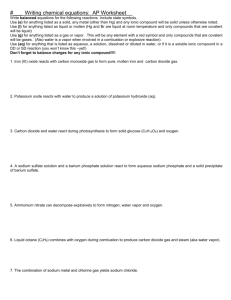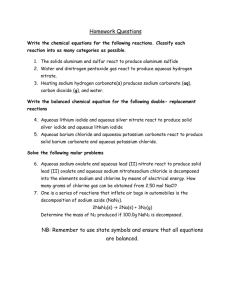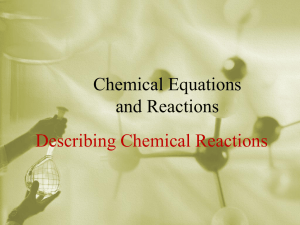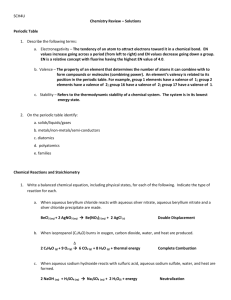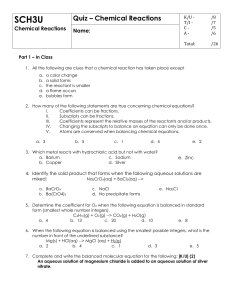word eqtn
advertisement
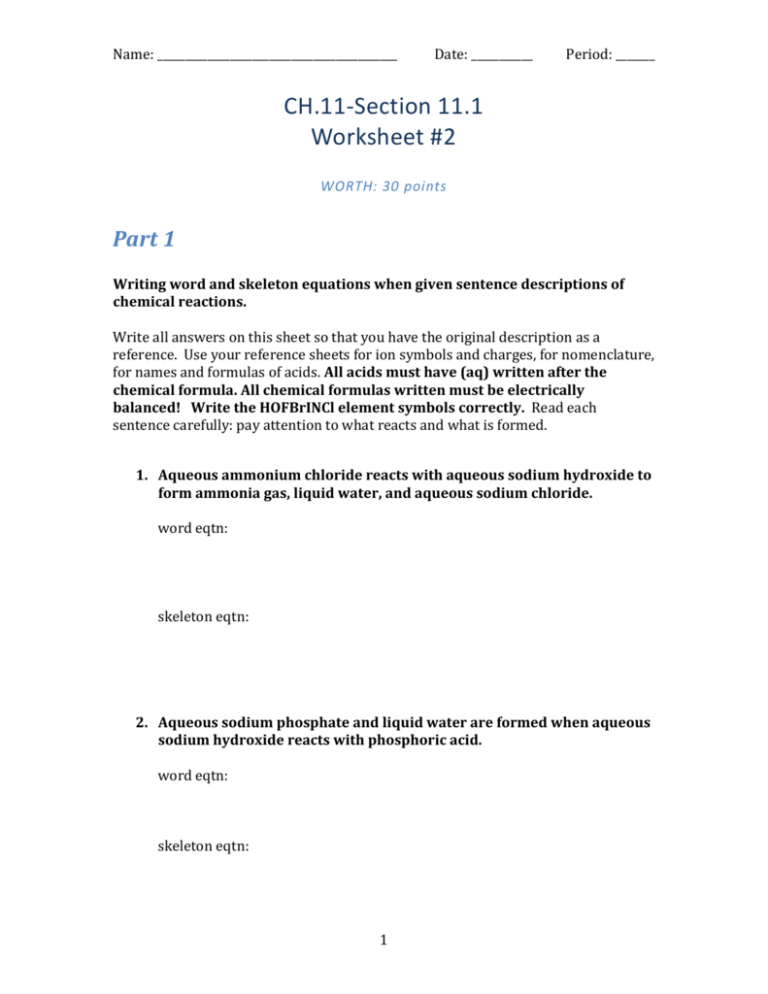
Name: ___________________________________________ Date: ___________ Period: _______ CH.11-Section 11.1 Worksheet #2 WORTH: 30 points Part 1 Writing word and skeleton equations when given sentence descriptions of chemical reactions. Write all answers on this sheet so that you have the original description as a reference. Use your reference sheets for ion symbols and charges, for nomenclature, for names and formulas of acids. All acids must have (aq) written after the chemical formula. All chemical formulas written must be electrically balanced! Write the HOFBrINCl element symbols correctly. Read each sentence carefully: pay attention to what reacts and what is formed. 1. Aqueous ammonium chloride reacts with aqueous sodium hydroxide to form ammonia gas, liquid water, and aqueous sodium chloride. word eqtn: skeleton eqtn: 2. Aqueous sodium phosphate and liquid water are formed when aqueous sodium hydroxide reacts with phosphoric acid. word eqtn: skeleton eqtn: 1 Name: ___________________________________________ Date: ___________ Period: _______ 3. When heated, solid carbon reacts with oxygen gas to form carbon monoxide gas. word eqtn: skeleton eqtn: 4. Solid carbon reacts with oxygen gas to form carbon dioxide gas. word eqtn: skeleton eqtn: 5. Solid sodium reacts with liquid bromine to form solid sodium bromide. word eqtn: skeleton eqtn: 2 Name: ___________________________________________ Date: ___________ Period: _______ 6. When heated, solid potassium chlorate yields solid potassium chloride and oxygen gas. word eqtn: skeleton eqtn: 7. When heated, solid calcium hydrogen carbonate yields solid calcium carbonate, carbon dioxide gas, and water vapor. word eqtn: skeleton eqtn: 8. Ethane gas, C2H6(g), reacts with oxygen gas to form carbon dioxide gas and water vapor. word eqtn: skeleton eqtn: 3 Name: ___________________________________________ Date: ___________ Period: _______ 9. Aqueous copper(II) nitrate reacts with aqueous sodium iodide to form solid copper(I) iodide, aqueous iodine, and aqueous sodium nitrate. word eqtn: skeleton eqtn: Part 2 Writing skeleton equations (including the physical state!) when given word equations. If one of the substances is an element, you must write the correct element symbol; be careful with elements that form diatomic molecules when they are not combined with other elements!) Write skeleton equations for each of the following word equations: 10. Potassium chlorate(s) potassium chloride(s) + oxygen(g) 11. Lead(IV) oxide(s) lead(II) oxide(s) + oxygen(g) 12. Aluminum(s) + lead(II) nitrate(aq) aluminum nitrate(aq) + lead(s) 4 Name: ___________________________________________ Date: ___________ Period: _______ 13. Potassium(s) + water(l) potassium hydroxide(aq) + hydrogen(g) _______________ 14. Sodium sulfite(aq) + hydrochloric acid sodium chloride(aq) + water(l) + sulfur dioxide(s) 15. Lead(II) nitrate(aq) + potassium sulfide(aq) potassium nitrate(aq) + lead(II) sulfide(s) 16. Calcium oxide(s) + diphosphorus pentoxide(s) calcium phosphate(s) 17. Potassium carbonate(aq) + barium chloride(aq) potassium chloride(aq) + barium carbonate(s) 18. Magnesium nitrate(aq) + sulfuric acid magnesium sulfate(aq) + nitric acid 19. Aluminum chloride(aq) + sulfuric acid aluminum sulfate(aq) + hydrogen chloride(g) 5 Name: ___________________________________________ Date: ___________ Period: _______ 20. Ammonia (g) + oxygen(g) nitrogen monoxide(g) + water(g) 21. Magnesium(s) + oxygen(g) magnesium oxide(s) 6

